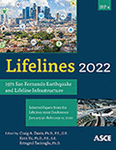Assessing Lifeline Interdependencies and Restoration Performance in San Francisco Using Qualitative Methods
Publication: Lifelines 2022
ABSTRACT
This paper documents outcomes of San Francisco’s efforts to assess post-earthquake interdependencies and restoration performance of lifeline systems serving the city. Two studies, completed in 2014 and 2020, used expert interviews with lifeline providers and cross-sector workshops to understand lifelines impacts from a major earthquake, restoration timelines and processes for each system, and lifelines interdependencies. New issues and changes in restoration performance between the first and second study were assessed. The studies resulted in current and target restoration timelines for all San Francisco lifelines using a common metric of level of service disruption and a clear understanding of interdependencies between lifelines. They also helped identify geographic areas with lifeline system concentrations or other vulnerabilities, key actions needed to achieve target restoration timelines, and high priority mitigation opportunities benefitting multiple systems. These efforts demonstrate the value of qualitative, collaborative approaches to assessing lifeline interdependencies, and restoration performance at a community-scale.
Get full access to this article
View all available purchase options and get full access to this chapter.
REFERENCES
ATC (Applied Technology Council). (2019). “Recommended Earthquake Performance Goals for San Francisco’s Buildings” (Draft).
Chang, S. E., McDaniels, T., Fox, J., Dhariwal, R., and Longstaff, H. (2014). “Toward disaster-resilient cities: Characterizing resilience of infrastructure systems with expert judgments.” Risk Analysis, 34 (3), 416-434. doi:https://doi.org/10.1111/risa.12133.
City and County of San Francisco. (2008). San Francisco Emergency Response Plan: Earthquake Annex. https://sfdem.org/sites/default/files/FileCenter/Documents/67-EQ%20Plan%202008.pdf (July 11, 2021).
City and County of San Francisco. (2014). Lifelines Interdependency Study | Report. April 17, 2014. https://sfgov.org/orr/sites/default/files/documents/Lifelines%20Council%20Interdependency%20Study.pdf (July 11, 2021).
City and County of San Francisco. (2019). Tall Buildings Safety Strategy. June 2019. https://www.onesanfrancisco.org/sites/default/files/inline-files/San%20Francisco%20Tall%20Buildings%20Safety%20Strategy_June%202019.pdf (July 11, 2021).
City and County of San Francisco. (2020). Lifelines Restoration Performance Project. October 2020. https://onesanfrancisco.org/sites/default/files/inline-files/Lifelines%20Restoration%20Performance%20Project%20Report_Oct%202020.pdf (July 11, 2021).
Detweiler, S. T., and Wein, A. M., eds. (2017). The HayWired earthquake scenario:. doi:https://doi.org/10.3133/sir20175013.
EERI (Earthquake Engineering Research Institute). (2019). “Functional Recovery: A Conceptual Framework with Policy Options.” December 6, 2019. https://www.eeri.org/wp-content/uploads/EERI-Functional-Recovery-Conceptual-Framework-White-Paper-201912.pdf (July 11, 2021).
Kircher, C., Seligson, H., Bouabid, J., and Morrow, G. (2006). “When the Big One Strikes Again – Estimated Losses Due to a Repeat of the 1906 San Francisco Earthquake.” Earthquake Spectra, 22, 297-339. https://doi.org/10.1193/1.2187067.
Nojima, N., and Kameda, H. (1991). “Cross-impact analysis for lifeline interaction,” Lifeline earthquake engineering, TCLEE Monograph 4, M. Cassaro, ed., American Society of Civil Engineers, Los Angeles, 629–638.
Nojima, N., and Kameda, H. (1996). “Lifeline interactions in the Hanshin-Awaji earthquake disaster.” The 1995 Hyogoken-Nanbu earthquake investigation into damage to civil engineering structures, Committee of Earthquake Engineering, Japan Society of Civil Engineers, Tokyo, 253–26.
Porter, K. A., and Sherrill, R. (2011). “Utility Performance Panels in the ShakeOut Scenario.” Earthquake Spectra, 27(2), 443-458. doi:https://doi.org/10.1193/1.3584121.
Port of San Francisco. (2021). “Embarcadero Seawall Program Overview.” https://www.sfportresilience.com/seawall-program (July 11, 2021).
SPUR (San Francisco Planning and Urban Research Association). (2009a). “The Resilient City: Defining what San Francisco needs from its seismic mitigation policies,” SPUR: San Francisco. https://www.spur.org/publications/spur-report/2009-02-01/defining-resilience (July 11, 2021).
SPUR (San Francisco Planning and Urban Research Association). (2009b). “Lifelines: Upgrading infrastructure to enhance San Francisco’s earthquake resilience,” SPUR: San Francisco. https://www.spur.org/publications/spur-report/2009-02-01/lifelines (July 11, 2021).
Satumtira, G., and Dueñas-Osorio, L. (2010). “Synthesis of modeling and simulation methods on critical infrastructure interdependencies research.” Sustainable and Resilient Critical Infrastructure Systems, 1-51, Springer: Berlin Heidelberg.
Scawthorn, C. (1993). “Lifeline interaction and post-earthquake functionality: Case study for fire following earthquake.” Proceedings of the 5th U.S.-Japan Workshop on Earthquake Disaster Prevention for Lifeline Systems, Tsukuba Science City, Japan.
Yao, B., Xie, L., and Huo, E. (2004). “Study effect of lifeline interaction under seismic conditions.” Proceedings of the 13th World Conference on Earthquake Engineering, Vancouver, B.C., Canada. https://www.iitk.ac.in/nicee/wcee/article/13_3152.pdf (July 11, 2021).
Information & Authors
Information
Published In
History
Published online: Nov 16, 2022
Authors
Metrics & Citations
Metrics
Citations
Download citation
If you have the appropriate software installed, you can download article citation data to the citation manager of your choice. Simply select your manager software from the list below and click Download.
